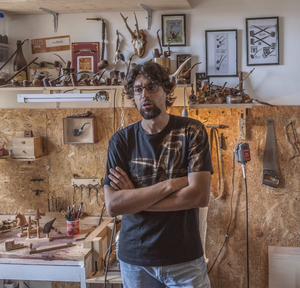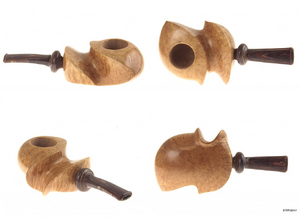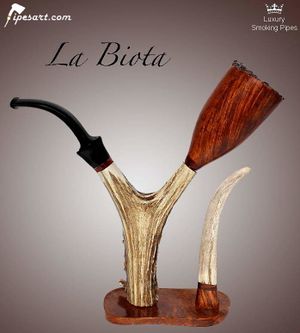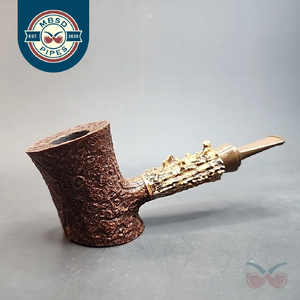La Biota
La Biota pipes are made by Michele Sottocasa (b. 1983) in Turin, in the north of Italy. Having previously studied photography and graphic design, Sottocasa worked as a graphic designer and art director before becoming a pipe maker in 2013. Sottocasa is a member of Italy’s Accademia della Pipa.
Sottocasa’s interest in pipes began in childhood, as his grandfather had been a pipe smoker. Sottocasa later became a pipe smoker himself, with his first forays into pipe making being through the crafting of his own smoking instruments. It was not until he felt that he had “reached artistic maturity,” that Sottocasa began making pipes for others. The name chosen by Sottocasa for this new venture into artisan pipe making was ‘la Biota.’
While many artisanal and factory pipes take their name from their makers or company founders, it is comparatively more common for Italian pipe brands to be given a name of their own, typically with an especial significance. ‘Ser Jacopone,’ for example, was the name of an early-modern Italian nobleman, and the namesake of Ser Jacopo pipes, with this Renaissance aesthetic reflected in their designs and presentation. Similarly, Le Nuvole (English: ‘The Clouds’) expressed an idea of pipes as cloud-like in both their uniqueness and their lightness. More contemporary examples include il Picchio Nero (‘the Black Woodpecker’), il Cerchio (‘the Circle’), and Alinetu (a mountain of the Aggius range in Sardinia). Il Biota, as a name, may be said to belong to this tradition.
In Italian and in English, ‘biota’ is an ecological term, designating the complex of flora and fauna in a particular habitat. In the Lombard dialect, “la Biota” also roughly translates to “the naked.” Both of these senses were in mind when Sottocasa baptized la Biota, and both remain central themes in the production of la Biota pipes. On the one hand, Sottocasa approaches pipes as being an object that intimates the connection between humans and nature, much in the way that the various flora and fauna of an ecosystem are bound together as a condition of their flourishing. Nature is a prominent theme more broadly in la Biota pipes, as Sottocasa finds much of the inspiration for his designs from frequent mountain walks in Italy’s northern region. Diego Morlin, renowned author of books such as La Pipa: I migliori marchi italiani and Io sono Baldo Baldi, writes:
“In line with the thought that ‘nature is the true artist and man can only interpret it’ stands the concept with which Michele [Sottocasa] demonstrates all his excellent skill, which distinguishes him from other pipe manufacturers. Michele is a master, he plays with nature and like a child he manipulates different objects composing them in a harmony that only he is able to find. This type of pipe is his signature.”
The second sense of “la Biota,” that of nakedness, is perhaps more subtly realized in Sottocasa’s work. He speaks somewhat cryptically on the matter, stating,
“the pipe cannot hide secrets but must be absolute truth. That is, it must be an object capable of saying everything, without the need for intermediaries.”
Given that Sottocasa also characterizes his work as eschewing “recurring typologies,” we may infer that these remarks refer to an ideal of univocity in la Biota pipes. In other words, Sottocasa’s view is that pipe makers should strive to create unique works that resist attempts to interpret them by way of something else – another pipe, a shape, or a particular school or tradition, for example. While Sottocasa speaks of his explorations of the Danish style and of a role played by more classical references in his designs, he qualifies this by stating that each pipe should maintain “its own definition”. With this in mind, Sottocasa does not use a traditional, metal lathe, opting instead to shape each pipe by hand on a wood lathe.[1]
The majority of la Biota pipes are made using briar, but Sottocasa also makes pipes from bog oak (morta) and olive wood. He is particularly fond of shank accents and uses a variety of materials for these embellishments. Horn rings and ferrules are particularly common features on la Biota Pipes. Sottocasa uses both acrylic and ebonite resins for his stems, all of which are hand cut. A gallery of some of Sottocasa's pipes is available below.
To date, la Biota pipes have been sold by Bollito Pipe and LePipe.it in Italy, PipesArt and Pfeifen Shop Online in Germany, and MBSD in the United States. Sottocasa also took part in the 2022 Ukraine Charity Pipes event organized by Nanna Ivarsson and Per Billäll through ScandPipes.
Gallery
Contact Information
Michele Sottocasa Website: www.la-biota.com Email: pipa.biota@gmail.com Instagram: https://www.instagram.com/la_biota_pipe/ Facebook: https://www.facebook.com/la.biota.pipe.artigianali/




